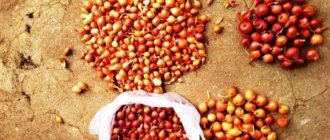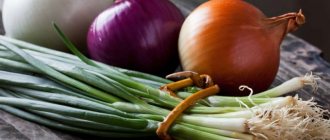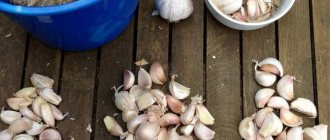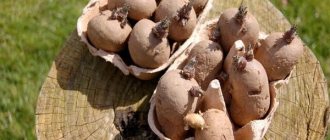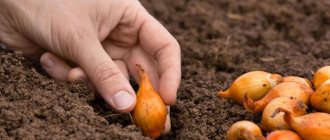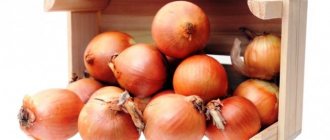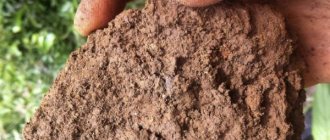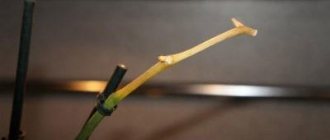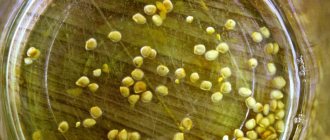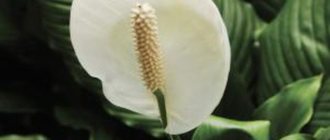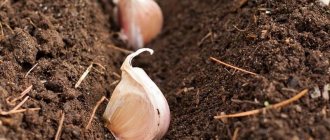Onions are not a capricious garden crop, and at the same time, not all summer residents can boast of high yields. The fault is the weather, poor-quality planting material, and most often the problem lies in improper preparation of onion sets for planting in the spring.
It’s not enough to grow nigella or buy selected onions; you need to know how to warm up, disinfect, and plant onion sets correctly. Simple and familiar procedures for gardeners to prepare for sowing take a little time, but the result will definitely please you.
Why process seedlings before planting?
Pre-sowing treatment of seedlings in the spring is necessary to protect the crop from pests and diseases. These are preventive measures that will prevent infection, because it is much more difficult to treat an already infected plant.
Pre-sowing treatment of onions allows:
- Stimulate growth.
- Destroy bacteria during disinfection.
- Strengthen immunity and resistance to diseases and pests.
- Prevent rotting of the onion head.
- Increase resistance to weather changes.
Diseases and pests
Onions can be susceptible to various diseases and pests. Moreover, some are active during storage, others during the growing season, which significantly affects the quality and quantity of the harvest. Some diseases and pests can cause irreparable damage to the crop. Bow can hit:
- Downy mildew.
- Cervical rot.
- Cercospora blight.
- Rust.
- Onion moth.
- Onion fly.
- Stem nematode.
- Scoop.
- Secretive beetle.
Important! The main problem when growing onions is bolting. This is a natural phase of cultural development.
How and how to process seedlings before planting
Processing onion sets before planting consists of several stages:
- Sorting.
- Warm up
- Hardening.
- Trimming.
- Soak.
Sorting
You need to choose seedlings depending on the climatic and agrotechnical characteristics of the area where you plan to grow onions. It is better to choose varieties that grow well in soil with moderate humidity and average air temperature.
If the variety does not tolerate rain and temperature changes, the yield will be weak.
Store planting material in a cardboard box or canvas bag in a room with an air temperature of +12-18 degrees.
Important! Sevok actively germinates at high humidity and high temperature.
- Sets that have been stored correctly have a distinct onion smell. If there is a smell of mold or rot, the bulbs are destroyed. They are not suitable for planting.
- On healthy bulbs, the husk is dry with a characteristic rustling sound.
- If there is moisture and dark spots on the head, this indicates the spread of fungus and mold. Damaged heads must be selected and removed so that they do not infect healthy ones.
- A healthy set should be firm and smooth, without damage.
20-30 days before planting, the seedlings are calibrated:
- Small - from 10 to 15 mm;
- Medium - from 15 to 20 mm;
- Large - from 20 to 40 mm.
Advice! Small and medium sowings produce high yields. Large onions take longer to germinate and are planted on greens.
Sorting will make it possible to get friendly shoots and choose healthy seedlings.
Warming up
To prevent bolting, the onions are heated in the spring. When storing planting material at home at a temperature of +18 degrees, additional heating is not needed. It is enough to expose it to the sun for several hours, covering it with a warm cloth.
But purchased seedlings must be warmed up in the spring. Warming up is carried out 3-4 days before planting. It is laid out in 1 layer near the heating device so that the heating temperature is within +35-40 degrees. To prevent the onions from drying out, cover them with a cotton cloth. The onion warms up for 10-70 hours.
If you don’t have enough time, you can fill the senchik with hot water for 15 minutes, and then water it with cold water. This express treatment will eliminate bolting, but will also extend the time it takes for them to form.
Hardening
Hardening will improve the onion's resistance to disease and reduce the likelihood of bolting. Hardened heads last longer and become harder.
The procedure is carried out in early spring. In the South - at the end of February, in central Russia - at the end of March.
Dry healthy bulbs are placed in a box and sent to the cellar or to the top shelf of the refrigerator for 10 days. The main thing is that they are kept at a temperature from 0 to +8 degrees. After the sowings, they are transferred to a warm place.
Advice! Express hardening is effective. After soaking, the heads are watered with ice water before planting, dried and warmed in the sun.
Soak
Soaking will improve immunity. There are many recipes for this procedure, so everyone will choose their own.
A saline solution will protect onions from onion flies, thrips and mites.
Potassium permanganate is effective against fungal spores. A weak solution allows you to destroy it, the main thing is to keep the onion in it for the required time.
To speed up the germination of seedlings, it is treated for 3-6 days with the growth stimulator Zircon, Epin, Gumat, Energen.
Let's take a closer look at the methods.
The main problems when growing onions
Some gardeners consider it normal to plant seedlings dryly, without any preparation. But this can only be done with completely healthy planting material that has been properly stored. Otherwise, the summer resident risks getting the following problems:
- fungal and bacterial diseases;
- damage to plantings by pests;
- shooting a bow.
Proper preparation of the seedlings before planting will help you avoid most of them.
First of all, the sets are carefully examined, sorted by size and bulbs with spots and traces of disease, soft and sprouted are rejected.
Secondly, the tips of the integumentary scales should be trimmed without affecting the growth point. Trimming will allow the bulbs to germinate faster, but this procedure is best done after soaking, when the upper scales are wet and it will be easier to clean.
How to prevent shooting
The appearance of arrows in onion beds is a consequence of improper storage of planting material during the winter. To ensure that the planted seedlings do not go to waste, it is necessary to observe the temperature, humidity and their ratios in the room during storage. If the conditions are not met, the bow begins to throw arrows.
If the sets were purchased in a store, it is recommended to warm them up before planting. They do this in two ways:
- Warming up at a temperature of about 30°C for a week. The seeds are poured onto a wooden tray in a layer of at least 2-3 cm and placed on the battery;
- Immediately before planting, the onions are poured with very hot water (60–65°C), soaked for 2 minutes, the water is drained and the procedure is repeated in cold water.
Warming up reduces the ability of the seeds to shoot arrows. Single specimens shoot even after warming up. Then the arrows are broken out as soon as they become noticeable.
Prevention of fungal diseases
To disinfect, planting material is soaked in disinfectant solutions. For this use:
- Salt. Stir a tablespoon of salt into 1 liter of warm water. Immerse the onion sets for 2-3 hours, then rinse them several times in clean water.
- Potassium permanganate. In a strong solution (3 g or half a teaspoon / 3 liters of water), the seeds are soaked for 2–2.5 hours, then thoroughly washed with clean water.
- Baking soda. 1 teaspoon is dissolved in 1 liter of warm water and the set is left for 2 hours.
- Fitosporin. The drug is diluted according to the instructions and the seeds are soaked in it for the prescribed time. After treatment with Fitosporin, the onions are not washed.
- Copper sulfate. 50 g of the drug is diluted in a small amount of hot water, then poured into a 10 liter bucket. The bulbs are disinfected for half an hour, then washed and dried.
More on Tele4n.Net:
Secrets of picking tomato seedlings in April - excellent DIY tomatoes
There is no need to use all the products at once. Folk remedies and the biological product Fitosporin are good only for prevention. Copper sulfate is considered more effective and is used in cases where in past years onion plantings suffered greatly from fungal diseases.
However, keep in mind that for prevention you need to carry out a set of measures, including following the rules of crop rotation and cultivating the soil to remove fungal spores.
Processing of sevka in biostimulants
Such procedures are not necessary, but will help to obtain strong plants with high immunity, and, as a result, a good harvest. To stimulate growth, the seeds are soaked in the following preparations:
- Epin-Extra. The biostimulator improves plant immunity, increases productivity and accelerates the formation of root crops. The drug must be used according to the instructions. Complex mineral fertilizer has similar properties. 1 tablespoon of fertilizer is diluted in a bucket of water and the seeds are soaked for a day.
- Ash. A half-liter jar of sifted wood ash is dissolved in a bucket of water, infused and the planting material is soaked in this solution for 2-3 hours. Ash is considered an excellent antiseptic and contains a lot of essential microelements.
Diseases and pests under favorable conditions can destroy a significant part of the crop. In addition, pathogens persist in the soil and on plant debris.
This will make it difficult to grow vegetables in future seasons. To prevent the development of diseases, it is necessary to prepare the onions selected for planting. These simple measures will help you get a high yield of healthy bulbs without the use of chemicals to treat plant diseases.
Onion fly: how to fight it?
Before planting, the seedlings need to be soaked to ensure a healthy harvest. Thus, onions are treated against onion flies before planting. Traditionally, for disinfection, it is recommended to soak onion sets for a couple of hours before planting in a saturated solution of potassium permanganate, saline solution or Fitosporin. But this doesn’t help much against the hero of our article.
Experienced gardeners recommend doing this: the prepared (cut) seedlings are placed in a warm mixture of water and tar (1 spoon per liter) and kept for 2-3 hours. Since tar mixes very poorly with water, floating on the surface in spots, the sowing in the container is stirred from time to time. It's better to cook onions outside - the smell is still amazing. The resulting bulbs will not arouse the appetite of pests, and the plantings will be safe.
How to get rid of onion fly
Let us remind you when it is most effective to combat this pest: for the first time - at the end of April (when dandelion, lilac, cherry bloom), for the second time - at the end of July.
Onion fly: how to fight with folk remedies
Joint plantings
And again we take advantage of the onion fly’s sensitivity to certain odors. If you plant savory, carrots, celery, tomatoes, and chamomile near the onions, there is a high probability that this insect will fly past your garden bed.
Ammonia for onion flies
We have already written about the wonderful properties of ammonia, also known as ammonia. This substance contains nitrogenous compounds that are easily digestible by plants, so ammonia is recommended to be used for onion plants and as a fertilizer for yellowed tips and a “tired” appearance. That is, we kill two birds with one stone! Concentration – 10-20 grams per bucket of water, about a glass per plant. Watering is best done on damp soil.
Previously, gardeners clearly knew how to treat onion flies - with saline solution
We thoroughly watered the soil in the garden bed, then watered the plants with saline solution, and watered them again with clean water. After two weeks, the treatment against onion flies was repeated with a stronger solution, and after another three weeks - with an even stronger one (one, one and a half, two glasses of salt are added to ten liters of water, respectively). This is a really effective method, but do you want to put that much salt into your soil? You decide.
Sprinkling the beds with dusty and odorous substances is also good against onion flies: ash, tobacco dust, tabazol (a mixture of tobacco dust and sunflower ash), ground pepper, naphthalene, ground wormwood (can be mixed, or in its pure form). After sprinkling, it is recommended to loosen the soil.
Infusions of strong-smelling herbs
This can be an infusion of dandelion, tobacco, tomato tops, wild rosemary, mint, fir, valerian, conifers.
If you want to fight the onion fly without adding anything to the garden bed, you can install pegs around the planting and stretch a long cloth soaked in kerosene over them.
Video: Protecting onions from onion flies and diseases in one product. How to prepare onion sets for planting
Onion fly: how to fight with drugs
Since this insect can be eradicated quite well (if you don’t miss it) with folk remedies, you don’t have to resort to chemicals in households. This is an option for farms and people growing vegetables for sale. However, such drugs exist:
- “Mukhoed”, “Medvetoks”, “Zemlin” - the soil is cultivated when planting seedlings
- “Sochva Zh”, “Aktara” - spraying onions
Fighting onion flies, a couple more tips:
- observe crop rotation: onions should be planted in the same place with an interval of at least three years;
- dig up the soil after harvesting to a depth of at least 20 cm. This will bring the larvae to the surface, they will not have time to pupate and die;
- safe proximity between onion beds is at least 400 meters. That is, if your land is clean and there are no larvae in it, this does not mean that the neighbor’s onion fly will not fly in and “throw” eggs at you. Therefore – prevention and prevention again!
This is what it is, an onion fly. The fight against such a widespread enemy must be proactive, because in a very short period the larvae can destroy the crop and make it unsuitable for storage. And since the choice of effective folk remedies is quite wide, the main thing here is not to be lazy and not to forget.
Have a good harvest!
From pests and diseases
Seeds for planting can be bought or grown from nigella seeds. Visually, it is impossible to understand whether it contains fungal spores and other harmful bacteria. Therefore, it is recommended to disinfect the seedlings.
Each tool will help cope with this task. They have their pros and cons that must be taken into account.
Potassium permangantsovka
Three types of potassium permanganate solution are used to disinfect seedlings:
A weak solution has little effect on microorganisms, but does not spoil the seed.
Gardeners recommend using a solution of medium consistency, which effectively destroys fungus and mold, but does not harm the seedlings.
A strong solution is used to treat sets infected with powdery mildew or onion fly. After it, the set acquires a dark color.
A weak solution of potassium permanganate is used to water the alkaline soil in the beds, but potassium permanganate will spoil acidic soil.
Salt
Allows you to strengthen your immune system and destroy harmful bacteria in the seeds. To prepare the solution, dissolve 5-6 tbsp in a bucket of water. spoons of salt. The seeds are placed in it for 4-5 hours. The beds are watered with weaker salt water for disinfection.
Important! Do not add a lot of salt or use this product frequently. It protects the crop from diseases, but spoils the soil for a long time. It is recommended to use the product once.
Saline solution is especially effective against stem nematodes, thrips and mites.
Soda
The simplest method is to treat the sevka with baking soda. Dissolve 1 tsp in 1 liter of warm water. soda and soak the onion in the solution for 2 hours. Next, the sets are dried.
Copper sulfate
Used when the quality of the seed is poor. In 1 bucket of warm water dilute 1.5 tbsp. spoons of the drug and keep the sowing for 2-3 hours. Next, the sets are dried.
Important! Onions cannot be treated with copper sulfate together with soaking in potassium permanganate or Fitosporin.
Phytosporin for fungus
Phytosporin will help protect onions from fungal infections. 35 g of the product are diluted in a bucket of water and the set is kept for 20-30 minutes.
Birch tar from onion fly
Birch tar will help deal with onion fly. Dilute 1 tbsp in 1 liter of water at room temperature. spoon of the product and keep the set for 2-3 hours. Next, the bulbs are dried.
Selection of planting material, preparation
It must be remembered that conscientious and painstaking adherence to all the rules for preparing onion sets for planting will ensure their abundant and rapid growth, and as a result will delight gardeners with a rich and high-quality harvest!
Processing and soaking onions before planting
First of all, when preparing the seedlings for planting, you need to carefully sort them out. Arm yourself with several sorting containers.
It is necessary to discard all damaged and small specimens, leaving medium-sized bulbs for planting on the head. Large onions, small ones, and even sprouted ones are suitable for greens. But we throw away the empty, wrinkled, missing ones.
Next, carefully cut off the dry tail on the top of each head with scissors. This simple operation will help them germinate faster and better. Well, you need to be afraid that an infection will get into the cut, because the seedlings will be treated for diseases before planting.
Should I soak onions before planting? And what is the best way to do this? Let's figure it out.
Of course, we are interested in our seedlings growing large and at the same time being protected from diseases and parasites. Therefore, a simple scheme is usually used: first, the planting material is soaked in growth stimulants, and a little later, immediately before planting, it is treated with protective agents.
To nourish the onion so that it grows large, it is recommended to dilute complex fertilizer in water (40-45 degrees) and soak the onion there overnight. When the seed is saturated with nutrients, you can begin its protective treatment and planting.
Most popular recipes:
- Soaking onions in potassium permanganate. Make a strong dark pink solution of potassium permanganate and soak the onions in it for 2-3 hours. After this, they will need to be washed under running water so that the concentrated potassium permanganate does not damage future young roots. Potassium permanganate prevents fungal and bacterial diseases.
- Soaking onions in saline solution. 1 tbsp. Dilute l salt in one liter of water, immerse the onions in it for 2-3 hours. Salt also prevents rotting and disease.
- Soaking in copper sulfate. 1 tsp copper sulfate per 10 liters of water, for 10-15 minutes. Copper sulfate disinfects seedlings and protects them from diseases.
These are time-tested ways to prepare onions. But time does not stand still, and we want to share with you new interesting recipes that will help comprehensively protect your plantings. One of these recipes is a combined treatment with salt, potassium permanganate and ash together in one solution. See below for how to do it:
Treating onions before planting with salt, potassium permanganate and ash
For a three-liter jar of warm (60 degrees) water, take 2 tbsp. l with a slide of salt dark pink solution of potassium permanganate 2 tbsp. l wood ash. Soak for 2 hours.
Treating onions before planting against pests with birch tar
The most nasty pest of onions is, of course, the onion fly. Luckily for us, she cannot stand the smell of birch tar. And if you want to protect your crops, then it would also be a good idea to soak the onions in the solution: 1 tbsp. l. tar in a liter of water for 10-15 minutes.
The same solution can be used to additionally water the plantings during the growing season.
Why is seed processing necessary?
Although onions are quite unpretentious to grow, it is necessary to carefully prepare the sets for planting in the spring. The quality of planting material is difficult to determine by eye, especially if the bulbs are small. Therefore, before planting onions, the planting material is prepared, including soaking.
Pre-sowing prevention will help separate good seeding from bad and improve the quality of the crop:
- Accelerate the ripening of heads and the emergence of greenery. Keeping the bulbs in water, even for a short time, stimulates the germination of roots - this significantly increases the rate of germination of onion feathers. In addition, saturating the seeds with water helps to increase productivity.
- Prevent shooting. Onions that are soaked in hot water are subject to temperature stress, which leads to the production of substances that block the formation of buds and the bolting of onions.
- Disinfect the bulbs. Soaking in solutions disinfects the seedlings, destroys pest larvae and prevents rotting and disease. If bulbous crops are planted annually in one place, there is a high probability that the crops will become infected with bulbous flies or bacterial diseases, in which case soaking is necessary.
More on Tele4n.Net:
Popular varieties of productive cucumbers for the greenhouse and vegetable garden, which varieties will give the best results.
To stimulate growth
To accelerate germination and obtain a good harvest, planting material is treated with growth stimulants.
Wood ash
The most popular and affordable product, rich in potassium and natural antiseptics.
This procedure also protects the onions from rotting after planting.
Dilute a 0.5 liter jar of ash in 10 liters of water and leave the bulbs for 10 minutes. Then they are dried for 2-3 hours.
Epin
The Epin capsule is dissolved in water at 50 degrees according to the instructions indicated on the package and the sowing is kept for 10-15 minutes.
You can also use Biostim, Silk according to the instructions.
Important! When planting in winter, onions are not treated with growth stimulants.
To reduce bolting
Warming up and hardening, which were described at the beginning of the article, are necessary to prevent the early formation of arrows.
Advice! It is better to soak the onions in a net, put a weight on top so that the seed does not float up. In this case, the load should not damage the sets.
The easiest way to prepare onions for planting is to soak them in clean water at +50 °C for 10-15 minutes.
Landing Features
We found out how to treat onions before planting in the spring, now let's look at how and when to plant them. It is worth saying that planting dates cannot be clearly defined. Experienced gardeners recommend starting sowing work as soon as the soil warms up to +12˚ C.
It is extremely undesirable to plant onions in cold soil, as this will cause the crop to shoot up.
However, you can’t be late with disembarkation either. Such a delay will lead to the fact that at first the green mass of the onion will grow rapidly, and the formation of the bulb will slow down. And even if the feather then develops more slowly, the formed bulbs will not begin to grow rapidly, but will still remain small.
Therefore, in the middle regions of Russia, in conditions of early and warm spring, onions can be planted already at the end of April.
To get a good harvest, you need to choose the right place to plant onions. Since this is a light-loving crop, the areas should be well-lit, on a hill (since the plant does not like stagnant water).
Preparing the beds
It is advisable to prepare the soil in advance - in the fall. The soil is dug up to a depth of 15-20 cm. At the same time, fertilizers (rotted manure, peat) are applied.
According to reviews from gardeners, fresh manure is not applied, as this can lead to onion diseases and increased growth of only the feather, and not the formation of the bulb.
Tip: For disinfection, you can water the furrows for planting onions with Fitosporin.
In the spring, you can additionally loosen the soil and apply mineral fertilizers. Only fertilizing must be done in several stages, since the plant reacts negatively to high concentrations of mineral fertilizers.
It is recommended to plant onions in areas where cucumbers, potatoes, cabbage, and tomatoes grew in previous seasons. It is not recommended to use beds after garlic and carrots.
Crop rotation rules: after which to plant onions and what can be planted after onions.
